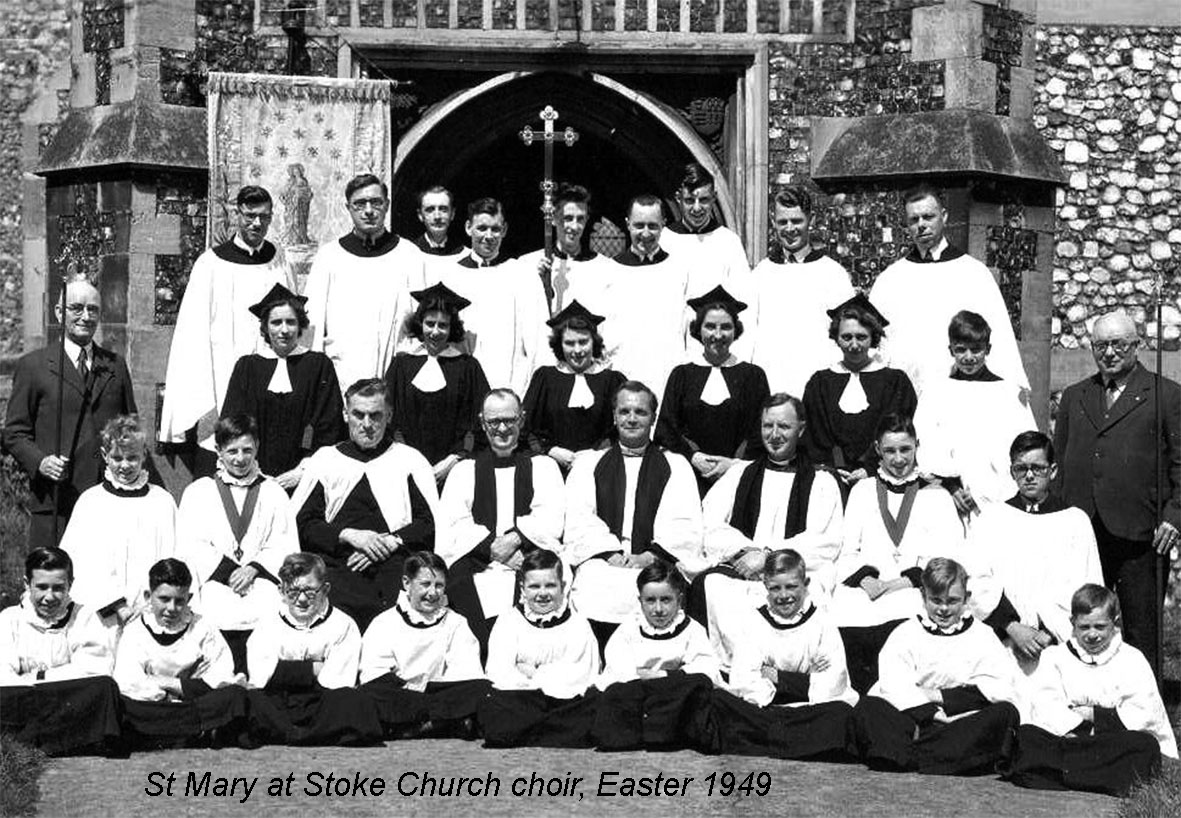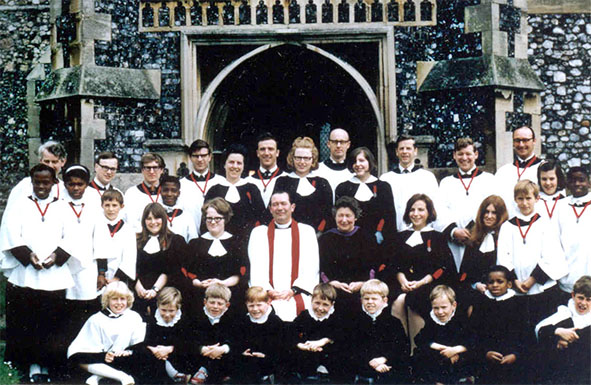- Screen Colours:
- Normal
- Black & Yellow
My parents and grandparents – all Stoke people – were committed members of the Methodist Church, in particular The People's Hall in Stoke Street, Ipswich. They were all very involved in the life of this active congregation throughout the years of WWII and I was baptised there. I recall being a member of their children's church and sang in their children's choir.
In the autumn of 1946 one of my school friends who lived near us in Belstead Road, called on me and asked if I would join the choir of St Mary at Stoke church. He was taking part in a choirboy recruiting exercise and told me that he would get sixpence if I came along, even if I only attended one practice. I could not remember ever having been in St Mary's church before. I am sure I talked to my parents about it and of going with my friend to a practice to find out more. It was, of course, only months since the end of the war and not many 10 year-olds were accustomed to wandering far from home in the evening on their own, certainly not after dark with no street lights. However, it was only 100 yards away and I went along – and was hooked.
I was initially enrolled as a boy-probationer/chorister and for services wore a black cassock and had to sit on the front row of the congregation with several other probationers, finding myself in the company of some other boys who I knew from school. I didn't sing in my first service until Easter 1947 on which occasion I was formally 'admitted' and presented with a certificate to mark the occasion.
There were then probably around a dozen boys aged from about 8 to 12 years, but numbers were increasing. Their recruitment campaign was obviously a success. Choir practices were held under the leadership of the organist/choirmaster Frank Andrews.

One of the first pieces of kit issued to all boys on joining was a bottle cork. At the beginning of each practice, scales were always sung and the cork had to be held between the front teeth to instil the habit of opening your mouth properly when you sang - at first quite a painful experience. One-hour practices for boys took place on Tuesday evenings - sometimes Wednesday as well and we joined with the adult members for an hour on Friday evening. As their voices deepened (or broke) some were moved to the back row of the choir stalls with the adults and taught to sing alto, tenor, or bass. Inevitably some failed to make this transition and left. Occasionally some left due to schooling pressures, so there was a fair degree of turnover.
This choral tradition at Stoke went back many years - as ancient photographs hanging on the vestry walls demonstrated. For services, all members were fully robed, wearing ankle-length black cassocks with white outer surplices. Boys additionally had to wear an infuriatingly stiff and sharply starched ruff which buttoned around the neck.
Over the next decade or so the predominantly male choir continued to grow. At one time it had around 22 boys and probably the same number of adults, which included a half dozen women who sang soprano or contralto. Several of the adults were parents of one or more of the boys and for some it became a family affair. With often a wedding or two on the Saturday to sing at and two services on the Sunday, for boys it was a busy, demanding week.
The rising standard of the choir’s singing was such that it became affiliated to the Royal School of Church Music and was able to participate in choirs’ festivals elsewhere in the county. Eventually, this standard of excellence led to it receiving invitations to sing the services at churches and cathedrals further afield whilst their resident choirs were away on tour or on holiday. These included cathedrals at Liverpool, Rochester, Salisbury, Coventry (where we sang the weekend services after Easter for seven years), and Chapel Royal at the Tower of London (during which there was a bomb alert, with the Tower being cleared entirely of the public, leaving us to sing Evensong in the chapel with a few Tower Warders as congregation). But one of the most daunting of all was St Paul's Cathedral. The organisational challenges faced were often considerable, involving the transportation (and sometimes overnight accommodation) of around 20 boys (some with their parents) and as many adult choristers. Young girls were only admitted to the choir in later years.

Photograph: The choir of St Mary at Stoke in 1973.
During the years up to age 15, boys were paid, the amount determined by a combination of age, seniority, and the number of attendances. There were additional payments for singing at weddings (of which there were quite a few), bonuses for singing solos and for recruiting new members. Occasional invitations were received to sing at funerals providing this did not interfere with schooling. For an 11 or 12 year-old it was immensely exciting to receive a quarterly pay packet of around 15 shillings.
Alas, the lives and interests of the younger generation now are much changed. We may all have a view as to whether this has been for better or worse. Although cathedrals, particularly those linked to colleges, have been able to hold on to the choral tradition (but even here, the closure of churches and cathedrals during the Covid lockdown has been giving serious cause for concern), for the majority of smaller churches, robed choirs are sadly fast disappearing, often at best being replaced by an adult singing group.
Perhaps of interest, at St Mary's (even though, of course, due to the pandemic lockdown the church was closed for many months) three of the adult male singers are still members – one having been choirmaster since 1969 – who were part of that exciting era, all having joined the choir during the 1940s.
But what the future holds for any parish church choir, we can only guess.
Some of the choir's engagements:-
1970 Salisbury Cathedral Evensong
1971 Norwich Cathedral Eucharist and Evensong
1972?. Chapel Royal, Tower of London Evensong
1973 St. Paul’s Cathedral Evensong
1973 Liverpool Cathedral Eucharist and Evensong
1974 Ely Cathedral Evensong
1974 Salisbury Cathedral Eucharist and Evensong
1975 Coventry Cathedral Evensong
1975 do. Eucharist and Evensong
1976 do. Evensong
1976 do Eucharist and Evensong
1977 Rochester Cathedral Eucharist and Evensong
1978 Coventry Cathedral Eucharist and Evensong
1979 do. Eucharist and Evensong
1982 do. Eucharist and Evensong
1987 Royal Albert Hall Massed Choirs Festival
John Barbrook